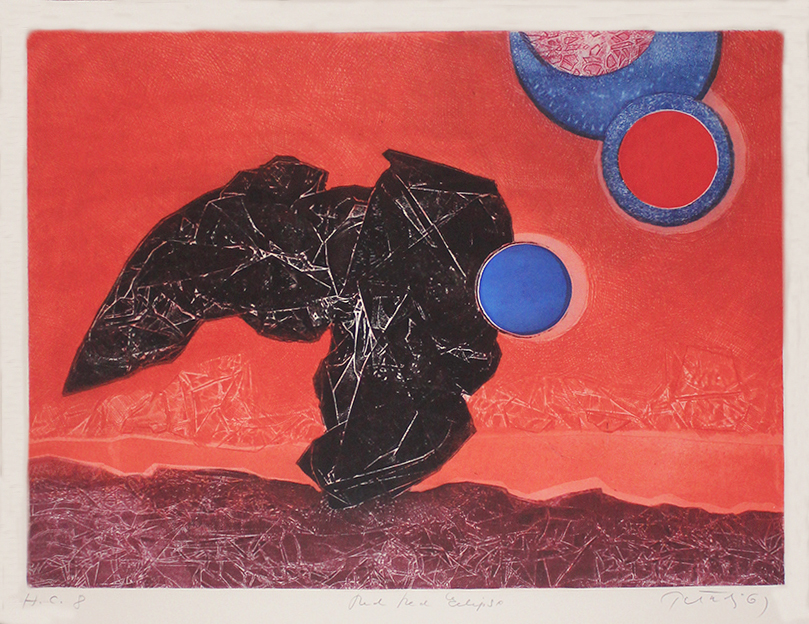Red, Red Eclipse is a mixed technique intaglio, printed in five colors, created in 1967 by Hungarian born American artist, Gabor Peterdi. Red, Red Eclipse is pencil signed, dated, titled and editioned H.C. 8 (Hors Commerce 8). This proof is outside of the edition of 150 published by Abe Lublin, Incorporated, New York. It is printed on a sheet of ivory Rives BFK wove paper and the platemark measures 17-1/2 x 23-1/4 inches. The reference is Peterdi 264 and is illustrated as a full color plate in the Touchstone Press book, Gabor Peterdi: Graphics 1934-1969.
In the early 1960s Gabor Peterdi had the opportunity to fly with bush pilots over regions of the Arctic. This experience informed his work of the mid 1960s and his imagery expressed landscape as flat areas with shimmering light. Peterdi produced a number of intaglios based upon the Arctic beginning in 1964. His Arctic Night IV was created in 1965 but then his imagery turned toward planetary eclipses with Eclipse I, Eclipse II, and Eclipse III, all published in 1966. Neither his interest in this theme nor his imagery were exhausted as he created Red Red Eclipse and Red and Blue Eclipse in 1967, followed by Red and Black Eclipse in 1968.
Gabor Peterdi, painter, printmaker, author, and educator, was born on 17 September 1915 in Pestújhely, Hungary. He began his art studies at the Hungarian Academy in 1929 at the age of fourteen. His first solo exhibition was mounted at the Ernst Museum in 1930 and that same year Peterdi won a Prix de Rome scholarship for painting which allowed him to continue his studies at the Accademia di Belle Arti. The following year he went to Paris where he attended the Académie Julian and the Académie Scandinave. He joined Hayter’s Atelier 17 in Paris in 1933 where he explored the techniques of engraving.
Peterdi immigrated to the United States in 1939 and, later that year, his first American solo exhibition of paintings opened at the Julien Levy Gallery in New York. He soon became a US citizen and joined the military serving in Germany. After his military service, Peterdi resumed his printmaking career at Atelier 17 in New York. He found working with the copperplate cathartic after his military experiences. His first prints reflected the horrors and destruction of war, but he soon began representing natural awakenings and biblical beginnings in such works as Adam and Eve.
He began teaching at the School of the Brooklyn Museum in 1948, organizing the graphic arts workshop there. Peterdi’s creative approach to intaglio continued to expand as he invented new techniques and printed from larger plates. In 1952, he became Associate Professor of Art at Hunter College, where he taught until 1959. In 1953, he began teaching at the Yale-Norfolk summer school, and he joined the art faculty of Yale University as a visiting professor, gaining a full-time appointment in 1960.
In 1959 Peterdi published his seminal book Printmaking Methods Old and New. It remains a standard technical reference for both printmaking students and professionals. Peterdi’s work garnered forty honors and is in the collections of the Museum of Fine Arts Boston, Massachusetts; the Brooklyn Museum, New York; the Art Institute of Chicago, Illinois; the Flint Institute of Art, Michigan; the Indianapolis Museum of Art, Indiana; the Hammer Museum, Los Angeles; the Memphis Brooks Museum of Art, Tennessee; The Yale University Art Gallery, New Haven, Connecticut; the Metropolitan Museum of Art, the Museum of Modern Art, the New York Public Library, and the Whitney Museum of American Art, New York; the Pennsylvania Academy of the Fine Art, Philadelphia; the Philadelphia Museum of Art, Pennsylvania; the National Gallery of Art and the Smithsonian American Art Museum, Washington, D.C.; and the Worcester Art Museum.
Gabor Peterdi died in Stamford, Connecticut on August 13, 2001.



